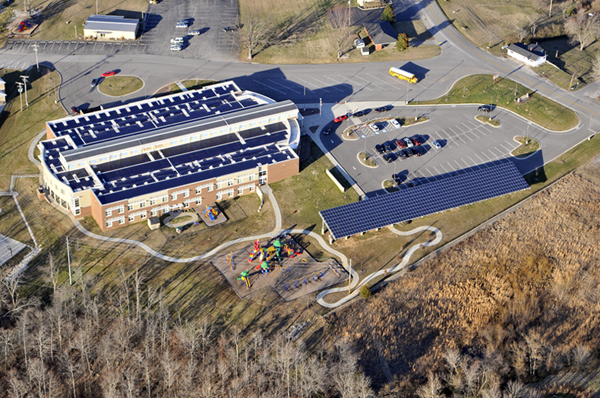July 14, 2013-by Chris Sikich in the Indianapolis Star. Ed. Note: valley watch.net editor, John Blair has done photography work for Brad Morton and Morton Solar and Wind.

Morton Solar operates in Illinois, Kentucky and Indiana. In Indiana they run into obstacles with their local utility which wants to charge ridiculous fees to connect to the Vectren grid. In Kentucky,a coal state, too, they find it much easier to build solar projects like this school just north of Bowling Green. Photo: © BlairPhotoEVV
Third-grade teacher Donya Bengert and her students learned a real-life lesson when they undertook a yearlong project to build a wind turbine in 2010 at their small Southern Indiana school.
They raised $25,000 from business grants and penny-jar donations. They won governmental and school board approvals. But when they were ready to install the turbine, Vectren Energy charged a $12,000 fee for a new transformer it said was necessary to handle the additional energy load.
“I almost had a heart attack,” Bengert said. “Oh my gosh, we spent almost a year raising all this money, we’ve got it all and we’re ready to go.
“But Vectren didn’t want to do it.”
The project’s installer, Brad Morton of Evansville-based Morton Solar & Wind, has filed a complaint with the Indiana Utility Regulatory Commission. He alleges that Vectren has violated state code the past eight years to stop or slow a number of renewable energy projects on which he has worked.
Vectren disputes the allegations, saying the utility follows state regulations and works to ensure renewable projects are safely and reliability added to the electrical grid.
Renewable energy advocates and contractors are watching the case closely, as they try to convince state policymakers and utilities that Indiana needs to further encourage cleaner alternatives to fossil fuels such as coal. They say the filing could have a wide effect on how much money utilities charge and how long they can take to process applications to fully connect solar and wind projects to the electrical grid.
Indiana ranks 39th lowest of the states in the percentage of renewable energy it generates. Only 3 percent of the power consumed in Indiana is from renewable energy, 9 percentage points behind the national average.
Kerwin Olson of Citizens Action Coalition, an advocacy group for energy policy and utility reform, said there is a clear resistance in Indiana to renewable energy.
“There are a lot of questions about the policy level at the Statehouse, at the regulatory commission and with utility business plans about whether they are really doing enough to enable renewable energy,” Olson said. (MORE)
